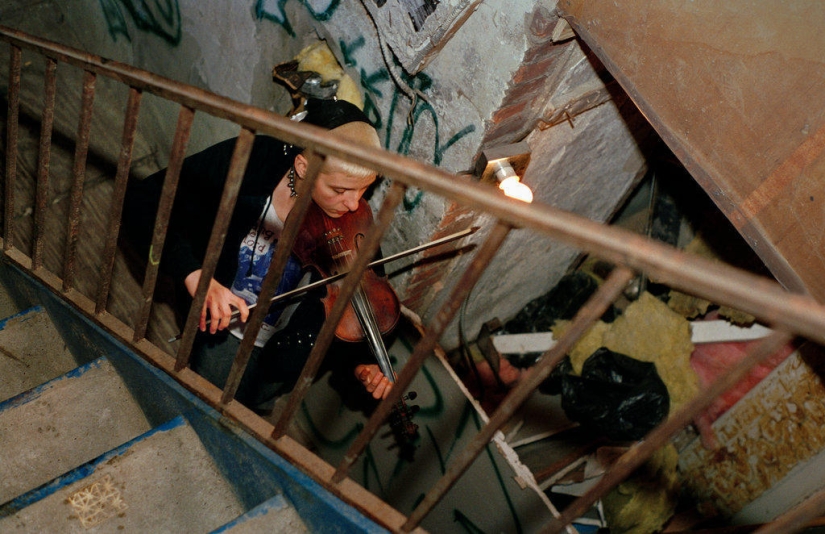Squatters' Paradise Lost
Categories: North America
By Pictolic https://pictolic.com/article/squatters-paradise-lost.htmlIn the early 1990s, Ash Thayer, an aspiring artist, had to move out of her Brooklyn apartment, and she found a new home in one of the squats on the Lower East Side. The girl managed to gain the trust of the inhabitants of See Skwat, unlike many journalists and photographers, who were now not welcome in newly inhabited houses. Later, Ash's photos were published in the form of the book Kill City.

When Ash Thayer became homeless in Brooklyn in 1992, she soon found a new home in the company of other squatters who occupied an abandoned building in the East Village. Then the girl was 19 years old, she loved to take pictures and was a beginner in the field of squatting, but soon realized that such a lifestyle suits her, in principle.
For the next seven years, Ash lived in several abandoned buildings, wandering from place to place. Of course, the authorities still consider such people to be delinquents, because squatters illegally live in houses that, although in disrepair, still officially belong to the city. The Fifth Street squat was one of these informal settlements, which soon came to an end.
 1. Jill and KD are relaxing in a squat on Fifth Street in Manhattan. Squatters themselves restored the roof of this abandoned building.
1. Jill and KD are relaxing in a squat on Fifth Street in Manhattan. Squatters themselves restored the roof of this abandoned building.
 2. A girl, whom friends called a Celebrity, with her child in an apartment in the Seventh Street squat in 1997.
2. A girl, whom friends called a Celebrity, with her child in an apartment in the Seventh Street squat in 1997.
 3. The kitchen in the squat on Fifth Street in 1995.
3. The kitchen in the squat on Fifth Street in 1995.
 4. Rest time in the Sea Squat building.
4. Rest time in the Sea Squat building.
 5. Another resident of the squat on Fifth Street is a dog named Pali, 1994.
5. Another resident of the squat on Fifth Street is a dog named Pali, 1994.
 6. Children's room in Serenity House in 1998.
6. Children's room in Serenity House in 1998.
 7. The Dregs concert at ABC NoRio, a collective center for art and activism on the Lower East Side in 1998.
7. The Dregs concert at ABC NoRio, a collective center for art and activism on the Lower East Side in 1998.
 8. Before the sewerage in the squat on Fifth Street, they wrote mainly in bottles.
8. Before the sewerage in the squat on Fifth Street, they wrote mainly in bottles.
 9. Free spirit and creativity are the norm for squat houses.
9. Free spirit and creativity are the norm for squat houses.
 10. Often squatters repaired their newfound housing with the help of used tools and materials "not the first freshness".
10. Often squatters repaired their newfound housing with the help of used tools and materials "not the first freshness".
 11. Entertainment time.
11. Entertainment time.
 12. Residents of Serenity House repair the stairs in 1997.
12. Residents of Serenity House repair the stairs in 1997.
 13. Although about a dozen squats were legalized in 2002, most of them did not "live up" to this point.
13. Although about a dozen squats were legalized in 2002, most of them did not "live up" to this point.
 14. View from the window of the Serenity House building in 1997.
14. View from the window of the Serenity House building in 1997.
 15. Musical interlude.
15. Musical interlude.
 16. Squat on Fifth Street in 1995. Windows were often left open to make it easier to move between apartments.
16. Squat on Fifth Street in 1995. Windows were often left open to make it easier to move between apartments.
 17. Smoke break.
17. Smoke break.
Recent articles

It is very important for children that a book has illustrations. Good design makes any story interesting and memorable. More than ...

Lovers of nature and outdoor recreation will find in Norway has the greatest variety of landscapes within one European country. ...

Every country in the world has its own peculiarities and secrets. Therefore, a tourist, even just walking along a street devoid of ...